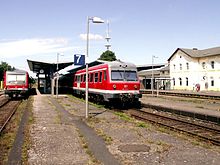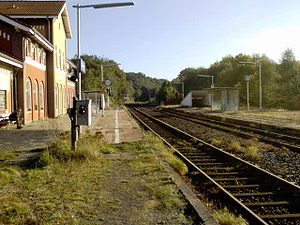Lüneburg–Soltau railway
The railway line Lüneburg- Soltau is a standard gauge railroad in the Osthannoverschen railways.
History
On 13 June 1913, the 57 km long route from Lüneburg to Soltau by the narrow-gauge railway Lüneburg- Soltau was opened after lengthy pre-planning. This was founded on 15 February 1911 by the Prussian State, the Province of Hanover and the districts of Lüneburg and Soltau.
It led from Lüneburg right through the Lüneburg Heath on Amelinghausen - Sottorf and Hützel. Here ends the railway line Winsen - Hützel, which had been built by the local railway Winsen - Evendorf - Hützel. Finally she reached the junction Soltau, where there was a joint railway station with the railway line Celle- Soltau and from 1920 also for railway Soltau- New Churches, besides also the transition possibility to the state railway. The management of the railway was from 1 June 1923 to July 1944 in the jurisdiction of the country's small railway Office of the Province of Hanover. After it came on 1 January 1944 merger of the Small Railroad Company in train Soltau- New Churches GmbH Lüneburg- Soltau railway GmbH, which was already on 11 July 1944, a part of the Osthannoverschen Railways AG.
The track is the elevation profile the most demanding of the OHE, the name " mountain railway " indicates. Nearly 100 feet of vertical drop to be overcome.
1973, the section Soltau- Hützel was integrated into the remote control distance from Celle. The signal box for it was in Soltau Süd. From a decline in traffic, the remote control has become superfluous; since 2001 it is no longer in operation on this section. The signals in Hützel and Lüneburg South were still controlled some time of Celle. Today ( 2012) is operated this route in Zugleitbetrieb after FV- NE. All signals are dismantled. The station Melbeck - Embsen previously disposed its own push button interlocking.
How 2012 became known considering the OHE long term shut down the section between Melbeck - Embsen and Hützel.
Operation
Passenger
The passenger traffic was modest in the early years. 1914 reversed four pairs of trains daily over the whole distance. 1932-1936 were acquired three Wismar rail buses that unwound the total passenger. Only the student and excursion traffic was driven locomotive-hauled trains. The offer was lawful, there were 1938 daily three through pairs of trains to run more pairs of trains on the legs Luneburg Amelinghausen and Soltau- Hützel. After 1950, five to six pairs of trains were run daily. Between 1950 and 1960, Hasten railcars were used which drove from Lüneburg to Celle to Soltau. From 28 May 1961, the passenger trains were introduced in the DB station Soltau. This brought relief during transfers. In Lüneburg, there was no agreement with DB, so that the DB railway station about a ten minute walk were back down.
As of 27 June 1975, passenger transport between Soltau and Schwindebeck the remaining passenger on May 21, 1977, set.
In March 2011, the section between the roundhouse and the Lüneburg South Railway Station, in favor of a new residential area was mined.
The Association of Friends traffic Lüneburg offers on weekends in the summer months and in December between Lüneburg and Hützel of rides with historic trains under the name " Heath - Express".
Lower Saxony's Ministry of Economy can check in passengers since mid- 2013, the reactivation of rail lines in Lower Saxony. Of the original 74 proposed routes are still being eight routes, including the route Lüneburg- Soltau, examined. The end of 2014 a decision on a possible resumption of the passenger traffic is scheduled on these routes.
Freight traffic
Initially mainly agricultural goods were transported. In the Lüneburg salt works had its own railway siding, it was an important customer. In Dröge Nindorf and Hambostel there were in the 1960s, mixing plants for road construction materials, they were temporarily large customers of the web. The most important shippers was the fertilizer plant in Embsen. There was a cargo volume of one million tons, in the best of times around 1980 made this freight 30 percent of the total volume of the OHE. In 1989, the fertilizer production in Embsen was abandoned. Was there until then three Nahgüterzüge daily on the route, there are 2006 or three a week. Also, the through traffic has declined. Was it in 1980, up to four trains daily, there are 2012 on the section Soltau- Hützel ( Winsen ) three trains per week. In the direction of Lüneburg, there are currently no scheduled traffic more.









